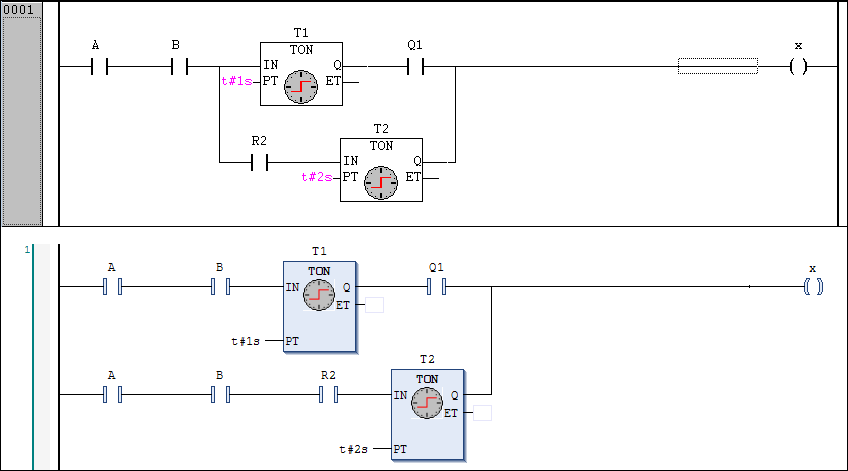Open a TwinCAT 2 PLC project
- TwinCAT XAE is started. A TwinCAT project is open. You should be aware of the restrictions described below the following guide.
- 1. Mark the PLC object in the view Solution Explorer and select the command Add Existing Item in the menu Project or the context menu.
- 2. In the dialog Open, select the desired Plc 2.x project or library from the file system. To search, you can set the file filter in the bottom right-hand corner of the dialog.
- After that the TwinCAT 2.x converter starts automatically.
- 3. The TwinCAT 2.x converter checks whether the project can be compiled without error. If so, it processes the project automatically.
If the project contains visualization objects with placeholder variables that the converter cannot resolve, the respective visualizations are integrated directly as a grouping in place of the visualization references. - 4. Library conversion: If a library for which no conversion rule has been defined yet is referenced in the project to be opened, the dialog Converting a library reference appears. Define here whether and how the converter should replace the previous library reference by an up-to-date one. If in doing so you select a library for which the project information is missing, the dialog Project information appears, which you have to fill out.
- The converter loads the adapted project.
Restrictions when reusing a TwinCAT 2.x project in TwinCAT 3.1
 | Automatic syntax adjustments only with previous compilability The syntax differs between TwinCAT 2 (TC2) and TwinCAT 3 (TC3) in certain respects (e.g. when initializing arrays). Please note that the converter only adapts the syntax at these code positions if the TwinCAT 2 project to be converted can be compiled on the TwinCAT 2 side. Specifically, this means: During the conversion process, the converter contained in TwinCAT 3 first compiles the selected TwinCAT 2 project with a TwinCAT 2 compiler. Syntax adjustments of the TwinCAT 2 code are only made during the creation of the TwinCAT 3 SPS project if this TwinCAT 2-side compilation is successful. The prerequisite for a successful TwinCAT 2-side compilation is that all necessary TwinCAT 2 libraries are made available to the converter. You can achieve this, for example, by inserting the libraries referenced in the TwinCAT 2 project into the folder C:\TwinCAT\3.1\Components\Plc\Converter\Lib. Alternatively, you can tell the converter the locations of the TwinCAT 2 libraries via the displayed conversion dialogs. |
Compilation | It must be possible to compile the project in TwinCAT 2.x PLC Control without compilation errors. Nevertheless, TwinCAT issues warnings during the compilation. These are evoked by implicit conversions that can lead to the loss of information (for example due to the change of a sign). TwinCAT 3.1 checks case statements against the switch variable: CASE USINT OF INT is not checked in TwinCAT 2.x, but there is an error message when importing into TwinCAT 3.1. |
Libraries | All variables and constants used in a library also have to be declared in this library. It must be possible to compile the library in TwinCAT 2.x without errors. |
Syntactic and semantic restrictions |
|
Memory |
|
Visualization
Placeholders and their replacement | Placeholder | VAR_INPUT | Use | Replacement | ||
| MAIN.$LocalVar$.aArr[0] | localVar: MyStruct; | localVar.aArr[0] | localVar := MAIN.myStructVar | ||
| $Var$.aArr[0] | Var : MyStruct; | Var.aArr[0] | Var := MAIN.myStructVar | ||
| MAIN.myStructVar.aArr[$Index$] | Index : INT; | MAIN.myStructVar.aArr[Index] | Index := 0 | ||
Problematic placeholders |
| |||||
Non-importable elements | Trend, ActiveX – the import is not possible because the implementation is very different. In TwinCAT 3.1 a corresponding warning is given and a corresponding manual reproduction is necessary. | |||||
Programming languages | ST, IL, FBD | No restrictions | ||||
| LD | TwinCAT 3.1 imports function blocks with parallel branches so that the part before the branch is repeated for each branch. This corresponds to the generated code that TwinCAT 2.x generates for parallel branches.
| ||||
| AS |
Explanation: Implicit variables that TwinCAT 3.1 creates for actions are given an underscore as a prefix in TwinCAT 3.1. An invalid identifier with a double underscore would result. | ||||
| CFC |
| ||||
See also:
